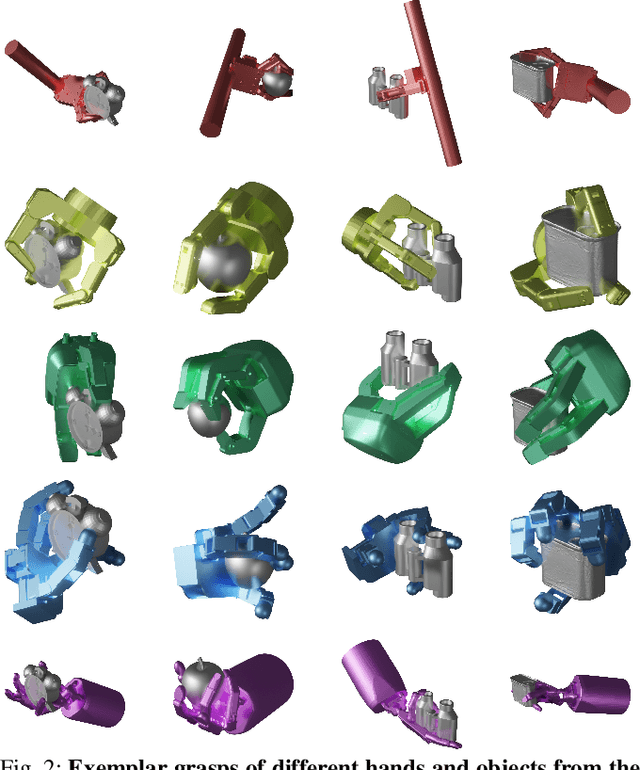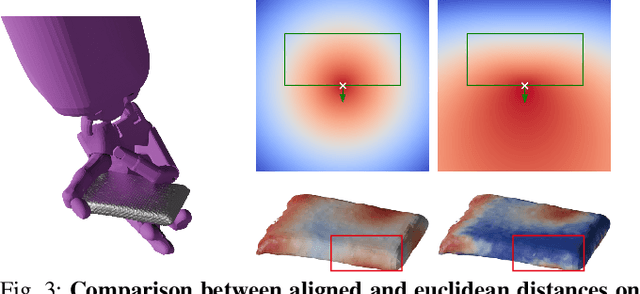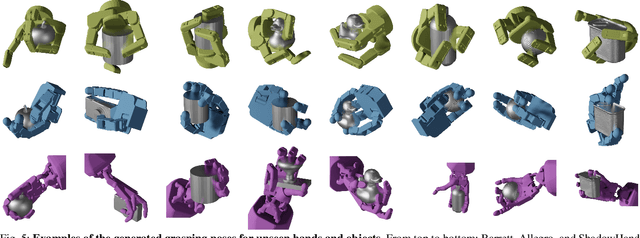Puhao Li
ManipTrans: Efficient Dexterous Bimanual Manipulation Transfer via Residual Learning
Mar 27, 2025Abstract:Human hands play a central role in interacting, motivating increasing research in dexterous robotic manipulation. Data-driven embodied AI algorithms demand precise, large-scale, human-like manipulation sequences, which are challenging to obtain with conventional reinforcement learning or real-world teleoperation. To address this, we introduce ManipTrans, a novel two-stage method for efficiently transferring human bimanual skills to dexterous robotic hands in simulation. ManipTrans first pre-trains a generalist trajectory imitator to mimic hand motion, then fine-tunes a specific residual module under interaction constraints, enabling efficient learning and accurate execution of complex bimanual tasks. Experiments show that ManipTrans surpasses state-of-the-art methods in success rate, fidelity, and efficiency. Leveraging ManipTrans, we transfer multiple hand-object datasets to robotic hands, creating DexManipNet, a large-scale dataset featuring previously unexplored tasks like pen capping and bottle unscrewing. DexManipNet comprises 3.3K episodes of robotic manipulation and is easily extensible, facilitating further policy training for dexterous hands and enabling real-world deployments.
PhysPart: Physically Plausible Part Completion for Interactable Objects
Aug 25, 2024



Abstract:Interactable objects are ubiquitous in our daily lives. Recent advances in 3D generative models make it possible to automate the modeling of these objects, benefiting a range of applications from 3D printing to the creation of robot simulation environments. However, while significant progress has been made in modeling 3D shapes and appearances, modeling object physics, particularly for interactable objects, remains challenging due to the physical constraints imposed by inter-part motions. In this paper, we tackle the problem of physically plausible part completion for interactable objects, aiming to generate 3D parts that not only fit precisely into the object but also allow smooth part motions. To this end, we propose a diffusion-based part generation model that utilizes geometric conditioning through classifier-free guidance and formulates physical constraints as a set of stability and mobility losses to guide the sampling process. Additionally, we demonstrate the generation of dependent parts, paving the way toward sequential part generation for objects with complex part-whole hierarchies. Experimentally, we introduce a new metric for measuring physical plausibility based on motion success rates. Our model outperforms existing baselines over shape and physical metrics, especially those that do not adequately model physical constraints. We also demonstrate our applications in 3D printing, robot manipulation, and sequential part generation, showing our strength in realistic tasks with the demand for high physical plausibility.
Ag2Manip: Learning Novel Manipulation Skills with Agent-Agnostic Visual and Action Representations
Apr 26, 2024



Abstract:Autonomous robotic systems capable of learning novel manipulation tasks are poised to transform industries from manufacturing to service automation. However, modern methods (e.g., VIP and R3M) still face significant hurdles, notably the domain gap among robotic embodiments and the sparsity of successful task executions within specific action spaces, resulting in misaligned and ambiguous task representations. We introduce Ag2Manip (Agent-Agnostic representations for Manipulation), a framework aimed at surmounting these challenges through two key innovations: a novel agent-agnostic visual representation derived from human manipulation videos, with the specifics of embodiments obscured to enhance generalizability; and an agent-agnostic action representation abstracting a robot's kinematics to a universal agent proxy, emphasizing crucial interactions between end-effector and object. Ag2Manip's empirical validation across simulated benchmarks like FrankaKitchen, ManiSkill, and PartManip shows a 325% increase in performance, achieved without domain-specific demonstrations. Ablation studies underline the essential contributions of the visual and action representations to this success. Extending our evaluations to the real world, Ag2Manip significantly improves imitation learning success rates from 50% to 77.5%, demonstrating its effectiveness and generalizability across both simulated and physical environments.
Move as You Say, Interact as You Can: Language-guided Human Motion Generation with Scene Affordance
Mar 26, 2024Abstract:Despite significant advancements in text-to-motion synthesis, generating language-guided human motion within 3D environments poses substantial challenges. These challenges stem primarily from (i) the absence of powerful generative models capable of jointly modeling natural language, 3D scenes, and human motion, and (ii) the generative models' intensive data requirements contrasted with the scarcity of comprehensive, high-quality, language-scene-motion datasets. To tackle these issues, we introduce a novel two-stage framework that employs scene affordance as an intermediate representation, effectively linking 3D scene grounding and conditional motion generation. Our framework comprises an Affordance Diffusion Model (ADM) for predicting explicit affordance map and an Affordance-to-Motion Diffusion Model (AMDM) for generating plausible human motions. By leveraging scene affordance maps, our method overcomes the difficulty in generating human motion under multimodal condition signals, especially when training with limited data lacking extensive language-scene-motion pairs. Our extensive experiments demonstrate that our approach consistently outperforms all baselines on established benchmarks, including HumanML3D and HUMANISE. Additionally, we validate our model's exceptional generalization capabilities on a specially curated evaluation set featuring previously unseen descriptions and scenes.
An Embodied Generalist Agent in 3D World
Nov 18, 2023Abstract:Leveraging massive knowledge and learning schemes from large language models (LLMs), recent machine learning models show notable successes in building generalist agents that exhibit the capability of general-purpose task solving in diverse domains, including natural language processing, computer vision, and robotics. However, a significant challenge remains as these models exhibit limited ability in understanding and interacting with the 3D world. We argue this limitation significantly hinders the current models from performing real-world tasks and further achieving general intelligence. To this end, we introduce an embodied multi-modal and multi-task generalist agent that excels in perceiving, grounding, reasoning, planning, and acting in the 3D world. Our proposed agent, referred to as LEO, is trained with shared LLM-based model architectures, objectives, and weights in two stages: (i) 3D vision-language alignment and (ii) 3D vision-language-action instruction tuning. To facilitate the training, we meticulously curate and generate an extensive dataset comprising object-level and scene-level multi-modal tasks with exceeding scale and complexity, necessitating a deep understanding of and interaction with the 3D world. Through rigorous experiments, we demonstrate LEO's remarkable proficiency across a wide spectrum of tasks, including 3D captioning, question answering, embodied reasoning, embodied navigation, and robotic manipulation. Our ablation results further provide valuable insights for the development of future embodied generalist agents.
Grasp Multiple Objects with One Hand
Oct 24, 2023Abstract:The human hand's complex kinematics allow for simultaneous grasping and manipulation of multiple objects, essential for tasks like object transfer and in-hand manipulation. Despite its importance, robotic multi-object grasping remains underexplored and presents challenges in kinematics, dynamics, and object configurations. This paper introduces MultiGrasp, a two-stage method for multi-object grasping on a tabletop with a multi-finger dexterous hand. It involves (i) generating pre-grasp proposals and (ii) executing the grasp and lifting the objects. Experimental results primarily focus on dual-object grasping and report a 44.13% success rate, showcasing adaptability to unseen object configurations and imprecise grasps. The framework also demonstrates the capability to grasp more than two objects, albeit at a reduced inference speed.
Diffusion-based Generation, Optimization, and Planning in 3D Scenes
Jan 15, 2023Abstract:We introduce SceneDiffuser, a conditional generative model for 3D scene understanding. SceneDiffuser provides a unified model for solving scene-conditioned generation, optimization, and planning. In contrast to prior works, SceneDiffuser is intrinsically scene-aware, physics-based, and goal-oriented. With an iterative sampling strategy, SceneDiffuser jointly formulates the scene-aware generation, physics-based optimization, and goal-oriented planning via a diffusion-based denoising process in a fully differentiable fashion. Such a design alleviates the discrepancies among different modules and the posterior collapse of previous scene-conditioned generative models. We evaluate SceneDiffuser with various 3D scene understanding tasks, including human pose and motion generation, dexterous grasp generation, path planning for 3D navigation, and motion planning for robot arms. The results show significant improvements compared with previous models, demonstrating the tremendous potential of SceneDiffuser for the broad community of 3D scene understanding.
DexGraspNet: A Large-Scale Robotic Dexterous Grasp Dataset for General Objects Based on Simulation
Oct 06, 2022



Abstract:Object grasping using dexterous hands is a crucial yet challenging task for robotic dexterous manipulation. Compared with the field of object grasping with parallel grippers, dexterous grasping is very under-explored, partially owing to the lack of a large-scale dataset. In this work, we present a large-scale simulated dataset, DexGraspNet, for robotic dexterous grasping, along with a highly efficient synthesis method for diverse dexterous grasping synthesis. Leveraging a highly accelerated differentiable force closure estimator, we, for the first time, are able to synthesize stable and diverse grasps efficiently and robustly. We choose ShadowHand, a dexterous gripper commonly seen in robotics, and generated 1.32 million grasps for 5355 objects, covering more than 133 object categories and containing more than 200 diverse grasps for each object instance, with all grasps having been validated by the physics simulator. Compared to the previous dataset generated by GraspIt!, our dataset has not only more objects and grasps, but also higher diversity and quality. Via performing cross-dataset experiments, we show that training several algorithms of dexterous grasp synthesis on our datasets significantly outperforms training on the previous one, demonstrating the large scale and diversity of DexGraspNet. We will release the data and tools upon acceptance.
GenDexGrasp: Generalizable Dexterous Grasping
Oct 03, 2022



Abstract:Generating dexterous grasping has been a long-standing and challenging robotic task. Despite recent progress, existing methods primarily suffer from two issues. First, most prior arts focus on a specific type of robot hand, lacking the generalizable capability of handling unseen ones. Second, prior arts oftentimes fail to rapidly generate diverse grasps with a high success rate. To jointly tackle these challenges with a unified solution, we propose GenDexGrasp, a novel hand-agnostic grasping algorithm for generalizable grasping. GenDexGrasp is trained on our proposed large-scale multi-hand grasping dataset MultiDex synthesized with force closure optimization. By leveraging the contact map as a hand-agnostic intermediate representation, GenDexGrasp efficiently generates diverse and plausible grasping poses with a high success rate and can transfer among diverse multi-fingered robotic hands. Compared with previous methods, GenDexGrasp achieves a three-way trade-off among success rate, inference speed, and diversity. Code is available at https://github.com/tengyu-liu/GenDexGrasp.
 Add to Chrome
Add to Chrome Add to Firefox
Add to Firefox Add to Edge
Add to Edge